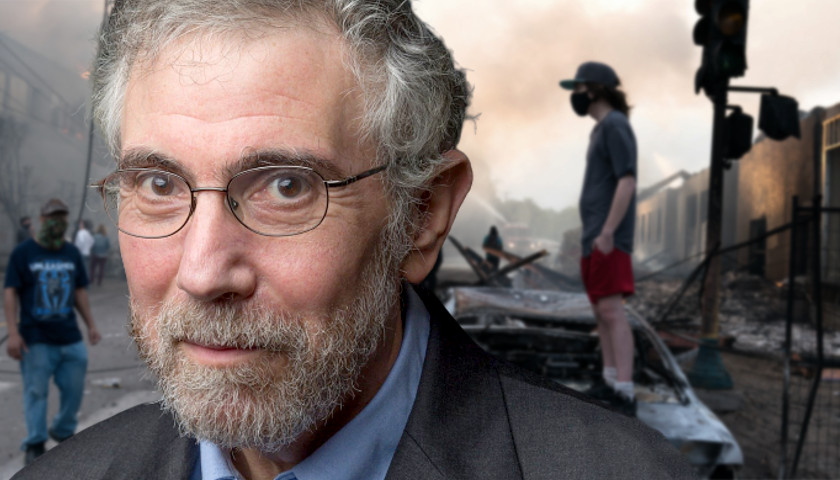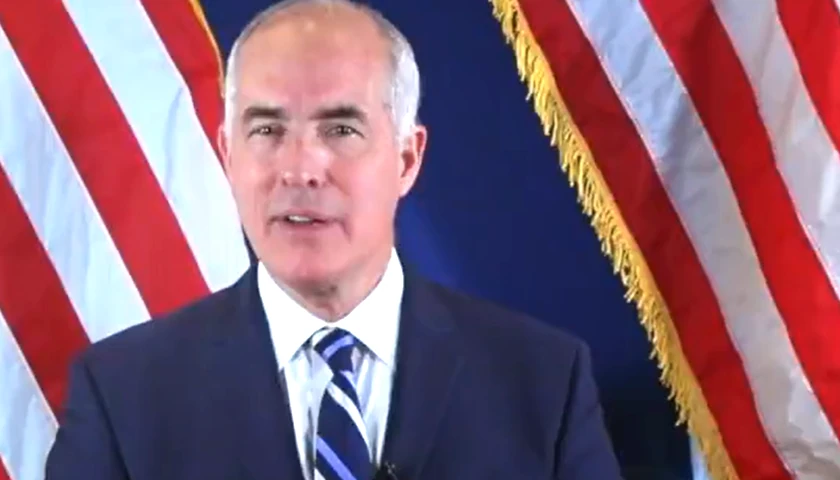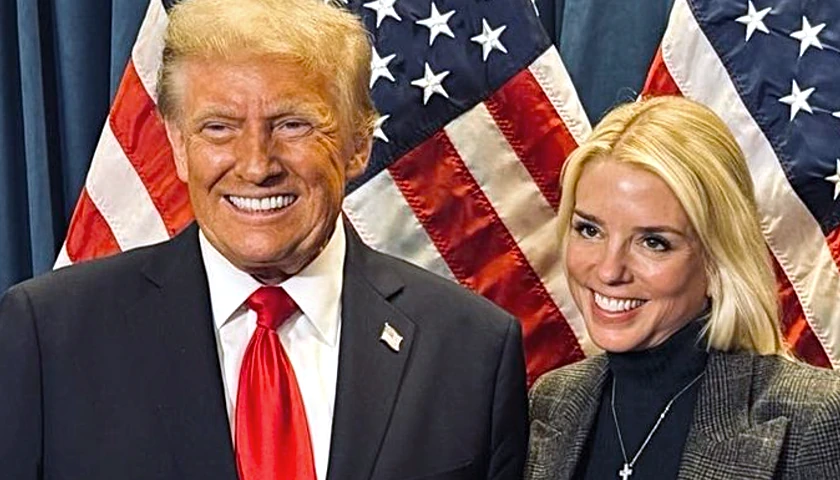by Roger Kimball
Don’t you just love Paul Krugman? One of loudest of the many anti-Trump hysterics employed by the New York Times, the former economist has been a reliable source of comedy at least since election night 2016. Once the worst was certain and the world learned that Donald Trump had indeed been elected president of the United States, Krugman pondered the markets, which had plunged overnight. “When might we expect them to recover?” he asked. “A first-pass answer is never . . . So we are very probably looking at a global recession, with no end in sight.”
What a card! I think we all deserve a Nobel Prize in economics. If Krugman can snag one, why not Stanley down at the bar? He says a lot of stupid things, too.
Krugman never disappoints. On Thursday, September 3, he published an opinion piece in the Times called “Trump and the Attack of the Invisible Anarchists.” The burden of the piece was twofold. On the one hand, having picked up that week’s propaganda memo from Democratic National Committee headquarters, he parroted the new talking point about the riots ripping (Democratic) cites apart.
Earlier this summer, the gospel was that there were no riots, only justly aggrieved citizens exercising their First Amendment rights to protest the heinous, cold-blooded murder of the violent career criminal and fentanyl abuser George Floyd. (Oops, that was from the teacher’s version of the manual: scrap “violent career criminal and fentanyl abuser.”)
At some point, that narrative was canceled. The new narrative admits that there are riots, but insists that they are all Donald Trump’s fault because . . .
Excuse me, we’re having trouble with reception. Forget that last bit: scratch “because” and just listen to the great Nobel laureate explain what’s really going on.
Enjoy a sleight of hand show? How’s this? The “anarchists” that Donald Trump and other knuckle-dragging neanderthals are trying to scare mama with don’t really exist, not really. Look again, those people rampaging on the streets of Portland, St. Louis, Seattle, Chicago, Oakland, Washington, D.C., Kenosha, New York: they’re invisible. Paul Krugman can’t see them. He walked across Central Park to his doctor and encountered no mayhem, none. “It was a beautiful day,” he noted, “and the city looked cheerful . . . Central Park was full of joggers and cyclists.” An aspiring if wayward disciple of Bishop Berkeley, Krugman seems to have adopted a variety of the central Berkelean principle of esse est percipi. If Krugman doesn’t perceive something, it doesn’t exist.
Poor Paul. He knows that people are alternately frightened and contemptuous of the media’s preposterous efforts to downplay the violence erupting in cities across the country, all those “fiery but mostly peaceful,” “intensifying into violence,” “not generally speaking unruly” jamborees that seem intended to calm the public’s nerves but actually heightened the sense of alarm.
So Krugman tries to have it both ways. The violence is monstrously overstated by the evil orange man and his minions. “[T]he property damage,” quoth Krugman, “has been minor compared with urban riots of the past,” “Portland is not ‘ablaze all the time‘” (not quite all of the time).
I think all of that was meant to soften us up, lull us into a state of dull acquiescence. Ready? Close your eyes, grab hold of Paul Krugman’s outstretched hand, and prepare for the big leap: la, la, la, ommmmm: “Much of the violence,” he says, “is coming not from the left but from right-wing extremists.”
Ah, our old friends, the “right-wing extremists”! I’ve missed them these last few months, haven’t you? You know them. They’re like that fellow walking down the street in Portland wearing a Trump hat last week. He was wearing a Trump hat. So, naturally, a “100 percent Antifa” member had to shoot him in the head in “self-defense.”
The media did not exactly condone that act. It was more akin to what happened following the assassination of President Kennedy. Question: Who killed John F. Kennedy? Answer: Lee Harvey Oswald, a Castro-loving communist. Almost instantly, however, a new narrative gelled and enveloped that stark but unpalatable truth. The man who pulled the trigger might have been a commie, but really, deep down, Kennedy was killed by (as James Reston put it) “extremists from the Right.” (If you want to know how that leap works – he is killed by a communist, but “extremists from the Right” get the blame – read James Piereson’s Camelot and the Cultural Revolution: How the Assassination of John F. Kennedy Shattered American Liberalism.)
Once you can accept that leap of faith, the next part is easy. “[T]here isn’t a wave of anarchy and violence,” Krugman wrote, really, “other than that unleashed by Trump himself.”
I’m sure you’ve seen the president or his minions at those Black Lives Matter and Antifa planning sessions, deciding which courthouses to target, what police stations to incinerate, what blocks of which cities to smash up, loot, and burn. It’s Donald Trump who has “unleashed” all the violence, all the mayhem, all the arson and murder, the far-Left Marxist foot soldiers of Antifa and BLM are just his puppets.
Breathtaking, isn’t it, not to say contemptibly incredible? But it is no less incredible than the obiter dicta about economics that Krugman lets drop as he makes his way through the political landscape. It is axiomatic with Krugman that Trump is a disaster for the country, not least for our economy. So, writing on Thursday, he predicted that while “Friday’s employment report is likely to show an economy still adding jobs” it would be “nothing like the ‘super V’ recovery Trump is still claiming.” Unemployment is “still very high,” he moaned, and the astonishing (my word) recovery that began in late April has “leveled off.”
Alas, Friday brought the news that we’d added 1.7 million jobs, against an expected 1.3 million, and that unemployment – still artificially high because the Democrats won’t let many Americans go back to work – edged down to 8.4 percent. In June, a canny pal noted that if the market held steady at around 25,000 and unemployment got down to 9 percent by Election Day, Trump would likely be reelected. Here we are two months out and the market is well north of 28,000 (it went well above 29,000 last week) and unemployment is falling.
No, here is the indigestible truth for the Democrats. Donald Trump has had the most successful first term of any president in memory, maybe ever.
His policies brought unemployment down to the lowest rate in decades, Among black and other minority populations, it was the lowest ever – ever. Wages, especially wages at the lower end, were rising, prescription drug prices were falling, and manufacturing was flooding back to the United States, a direct result of Trump’s America First trade policies. He came to office promising to lose two regulations for every new one enacted, but has managed to lose nearly 20 regulations for every new one. His exploitation of America’s energy resources have not only made the country energy independent, they have made us a net exporter of energy.
Trump has made extraordinary progress on other fronts as well, from his hundreds of judicial appointments to reducing the flow of illegal immigration by 90 percent. On the cultural front, he has defanged the tyranny of Title IX despotism in colleges and universities and, just a day or two ago, he issued an executive order instructing the Office of Management and Budget to “identify and eliminate any trace of ‘critical race theory’ in the federal government.”
It would be difficult to overstate the significance of this order. Critical race theory is the pseudo-academic version of identity politics, lending a suitable polysyllabic veneer of obfuscation to the brutish Marxoid and America-hating ideologies of Antifa, Black Lives Matter, and kindred sites of festering discontent.
But what about the Chinese flu, the dreaded coronavirus, the plague that has otherwise normal people covering their faces and cowering in place? Well, what about it? Krugman adverts to it only in passing. “A few months ago the Trump campaign clearly hoped that it could put the coronavirus behind it. But the virus declined to cooperate.”
Oh, gee, “the virus declined to cooperate.” But you know what? It did cooperate – or to speak more frankly, it acted exactly as one would expect a virus to act.
Who is the politician whose decisions about dealing with the new flu led to the most deaths? Andrew Cuomo, somehow still the governor of New York. What politician saved the most lives by his preemptive action and mobilization of federal resources? President Donald J. Trump. You might not like it. Paul Krugman abominates it. But there you have it. That’s the way things are Labor Day weekend 2020.
– – –
Roger Kimball is editor and publisher of The New Criterion and the president and publisher of Encounter Books. He is the author and editor of many books, including The Fortunes of Permanence: Culture and Anarchy in an Age of Amnesia (St. Augustine’s Press), The Rape of the Masters (Encounter), Lives of the Mind: The Use and Abuse of Intelligence from Hegel to Wodehouse (Ivan R. Dee), and Art’s Prospect: The Challenge of Tradition in an Age of Celebrity (Ivan R. Dee).
Photo “Paul Krugman” by Paul Krugman and photo “Minnesota Rioters” by Laurie Shaull CC2.0.




